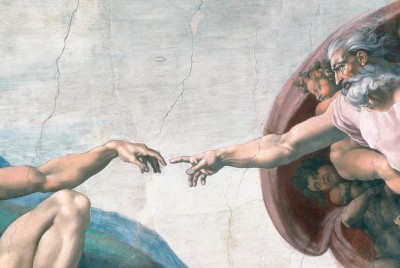A revelation, if anticipated, must first meet and then exceed the expectations of those who recognize it. It must fulfill the old law even by transforming it. As in Luke 16:16:
The law and the prophets were until John; since then the good news of the kingdom is preached, and every one enters it violently. But it is easier for heaven and earth to pass away, than for one dot of the law to become void.
— (RSV)
‘For heaven and earth to pass away’ is for historical time to become imaginary – as indeed it is, since all we know of past and future is what we know now. Revelation raises the body of truth, as resurrection raises the true body, from temporary or temporal presence (i.e. location on an imagined timeline) into eternal presence. At the apocalypse, the arrival of ‘the world that is coming,’ even the stone tablets come to life again.
But that the dead are raised, even Moses showed, in the passage about the bush, where he calls the Lord the God of Abraham and the God of Isaac and the God of Jacob. Now he is not God of the dead, but of the living, for all live to him.
— Luke 20:37-8, RSV
Resurrection and revelation are not mere historical facts but actual present experiences. Such an experience, seen from the outside, would be a phase shift in brain dynamics, one that changes everything for the bodymind subject to it. Revelation could be triggered, for instance, by an analogy; the violence of which Luke speaks is the feeling of a mindquake shaking the foundations of meaning, destroying and making it new. Mark Turner describes the process thus (1991, 125):
Analogies can inventively induce us to construct new connections, and recast or tune others. A powerful analogy can restructure, disturb, influence, and change our category structures, and successful analogical connections (light is a wave) can ultimately become part of our category structures. Some of the connections that analogies propose might mesh with our category connections and thus be easily assimilated. Others might be deeply disruptive, with the consequence that their assimilation will be resisted by the conceptual apparatus we already have in place. A deep, surprising analogy that leads us to form weird but powerful connections that challenge our category structures will not settle readily into our conventional knowledge. It will remain suggestive, never achieving a location in our conceptual apparatus. It will not be used up – assimilated and naturalized – as we go through it repeatedly: we will be able to return to it again and again, and find it fresh, because the connections it suggests cannot be established in our category structures (or maybe even in our conventional conceptual apparatus) with impunity.
This is what Wallace Stevens (1957) calls ‘poetry,’ a ‘renovation of experience’ which ‘must resist the intelligence almost successfully.’ Turning signs are precisely those that we cannot assimilate, that is, cannot turn over to the unconscious in the form of habits, and thus they are always fresh. But sometimes we are not up to the challenge of reading them anew. Then, if we have a hunger for transformation, we are tempted to look elsewhere for the turning sign – anywhere but within ‘our conventional conceptual apparatus.’ Anything out there can potentially trigger the transformation, but unless the potential is realized, nothing happens. If the epiphany does occur, it is like being struck by lightning, everything is lit up. In either case the transformation cannot be located either in the transformed world or in time.
The days are coming when you will desire to see one of the days of the Son of man, and you will not see it. And they will say to you, ‘Lo, there!’ or ‘Lo, here!’ Do not go, do not follow them. For as the lightning flashes and lights up the sky from one side to the other, so will the Son of man be in his day. But first he must suffer many things and be rejected by this generation.
— Luke 17:22-25 (RSV)
As Northrop Frye says (1982, 133), the ‘ability to absorb a complete individual is, so far, beyond the capacity of any society … society will always sooner or later line up with Pilate against the prophet.’ Of course a revelation ‘will be resisted by the conceptual apparatus we already have in place’! If it were not, there could be no transformation, only minor adjustments. And as Turner also points out, it is this resistance which keeps a sign such as an analogy fresh. There are some truths you can never take for granted no matter how many times they are granted to you, because they challenge the very basis on which they are understood. For instance: Even though you know that the world is wholly contained in the bodymind and the bodymind wholly contained in the world, these inclusions continue to appear mutually exclusive, and thus to continue as revelations.
